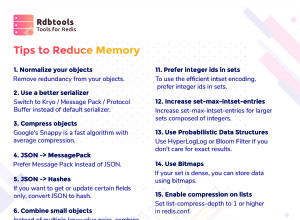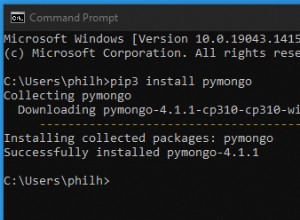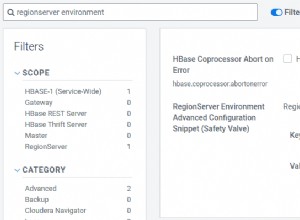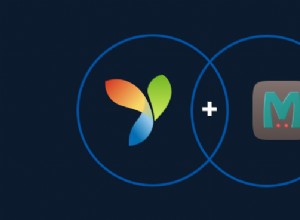In realtà, l'altra risposta è sbagliata. È possibile eseguire una ricerca su un campo DBref all'interno del tuo aggregatore e non hai bisogno di mapreduce per questo.
Soluzione
db.A.aggregate([
{
$project: {
B_fk: {
$map: {
input: {
$map: {
input:"$bid",
in: {
$arrayElemAt: [{$objectToArray: "$$this"}, 1]
},
}
},
in: "$$this.v"}},
}
},
{
$lookup: {
from:"B",
localField:"B_fk",
foreignField:"_id",
as:"B"
}
}
])
risultato
{
"_id" : ObjectId("59bb79df1e9c00162566f581"),
"B_fk" : null,
"B" : [ ]
},
{
"_id" : ObjectId("582abcd85d2dfa67f44127e1"),
"B_fk" : [
ObjectId("582abcd85d2dfa67f44127e0"),
ObjectId("582abcd85d2dfa67f44127e1")
],
"B" : [
{
"_id" : ObjectId("582abcd85d2dfa67f44127e0"),
"status" : NumberInt("1"),
"seq" : NumberInt("0")
}
]
}
Breve spiegazione
Passa in rassegna i DBRef con $map, suddividi ogni DBref in un array, mantieni solo il campo $id, quindi elimina il formato k:v con $$this.v, mantenendo solo ObjectId e rimuovendo tutto il resto. Ora puoi cercare su ObjectId.
Spiegazione passo dopo passo
All'interno dell'aggregatore, un tipo BSON DBRef può essere gestito come un oggetto, con due o tre campi (ref, id e db).
Se lo fai:
db.A.aggregate([
{
$project: {
First_DBref_as_array: {$objectToArray:{$arrayElemAt:["$bid",0]}},
Second_DBref_as_array: {$objectToArray:{$arrayElemAt:["$bid",1]}},
}
},
])
Questo è il risultato:
{
"_id" : ObjectId("582abcd85d2dfa67f44127e1"),
"First_DBref_as_array : [
{
"k" : "$ref",
"v" : "B"
},
{
"k" : "$id",
"v" : ObjectId("582abcd85d2dfa67f44127e0")
}
],
"Second_DBref_as_array" : [
{
"k" : "$ref",
"v" : "B"
},
{
"k" : "$id",
"v" : ObjectId("582abcd85d2dfa67f44127e0")
}
]
}
Dopo aver trasformato un dbref in un array, puoi eliminare i campi inutili interrogando solo il valore all'indice 1, in questo modo:
db.A.aggregate([
{
$project: {
First_DBref_as_array: {$arrayElemAt: [{$objectToArray:{$arrayElemAt:["$bid",0]}},1]},
Second_DBref_as_array: {$arrayElemAt: [{$objectToArray:{$arrayElemAt:["$bid",0]}},1]},
}
},
])
risultato:
{
"_id" : ObjectId("582abcd85d2dfa67f44127e1"),
"First_DBref_as_array" : {
"k" : "$id",
"v" : ObjectId("582abcd85d2dfa67f44127e0")
},
"Second_DBref_as_array" : {
"k" : "$id",
"v" : ObjectId("582abcd85d2dfa67f44127e0")
}
}
Quindi puoi finalmente ottenere il valore che desideri puntando a "$myvalue.v", proprio in questo modo
db.A.aggregate([
{
$project: {
first_DBref_as_array: {$arrayElemAt: [{$objectToArray:{$arrayElemAt:["$bid",0]}},1]},
second_DBref_as_array: {$arrayElemAt: [{$objectToArray:{$arrayElemAt:["$bid",0]}},1]},
}
},
{
$project: {
first_DBref_as_ObjectId: "$first_DBref_as_array.v",
second_DBref_as_ObjectId: "$second_DBref_as_array.v"
}
}
])
risultato:
{
"_id" : ObjectId("582abcd85d2dfa67f44127e1"),
"first_DBref_as_ObjectId" : ObjectId("582abcd85d2dfa67f44127e0"),
"second_DBref_as_ObjectId" : ObjectId("582abcd85d2dfa67f44127e0")
}
Ovviamente, in una normale pipeline, non hai bisogno di tutti questi passaggi ridondanti, usando una $map nidificata, puoi ottenere lo stesso risultato in una volta sola:
db.A.aggregate([
{
$project: {
B_fk: { $map : {input: { $map: { input:"$bid",
in: { $arrayElemAt: [{$objectToArray: "$$this"}, 1 ]}, } },
in: "$$this.v"}},
}
},
])
risultato:
{
"_id" : ObjectId("582abcd85d2dfa67f44127e1"),
"B_fk" : [
ObjectId("582abcd85d2dfa67f44127e0"),
ObjectId("582abcd85d2dfa67f44127e1")
]
}
Spero che la spiegazione sia sufficientemente chiara, altrimenti chiedi pure.




